For the second part of the Underground Colosseum Tour, our guide Michele took us up into the public area. (Read Part 1 by clicking here)
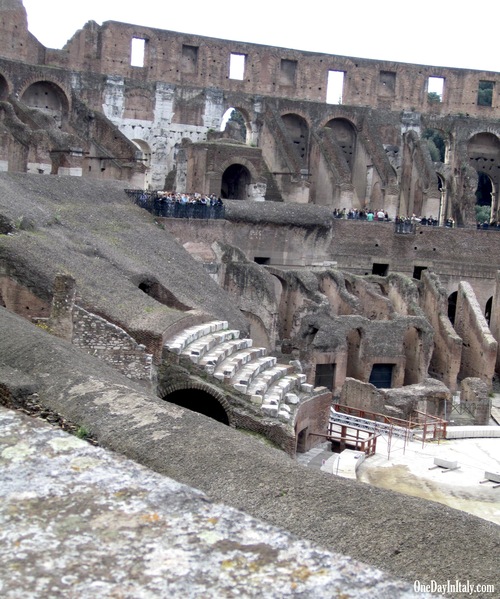
At one end of the Colosseum, above where they’ve created a reconstruction of the arena floor, they’ve also replicated part of the arena seating. Everyone in the arena had a ticket and was arranged by social class. Where these seats are would’ve been the Roman senators’ seats. Moving up the arena in height the plebeians would’ve been next, then the poor – and THEN the women. Really?!
An entrance was specified on each ticket so that the social classes didn’t have to mix. Couldn’t have anyone brush shoulders with the women, after all… that would’ve been too degrading. Oye!
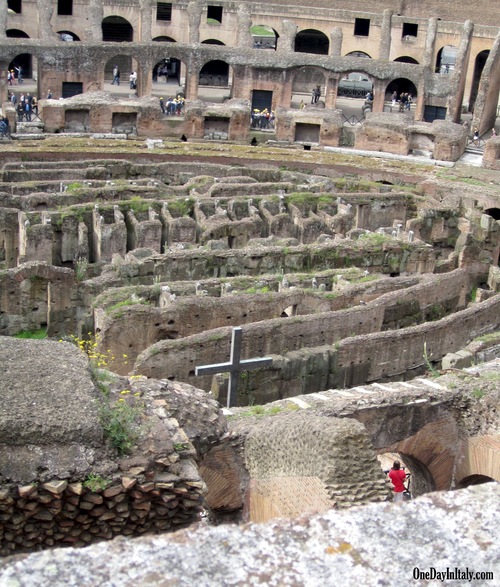
When the Christian regime took over Rome and the Colosseum (the last recorded gladiatorial games were in 435AD, the last animal hunt in 523AD), they erected this cross in honor of Christian martyrs. Ironically, no Christians were ever martyred in the Colosseum (even if there were Christians who died in combat among the slaves / gladiators, they weren’t killed because they were Christians, so they weren’t technically martyrs).

After a quick lap around the public viewing area of the Colosseum, we again went through a set of stanchions to enter a restricted area as we climbed up to a higher level.
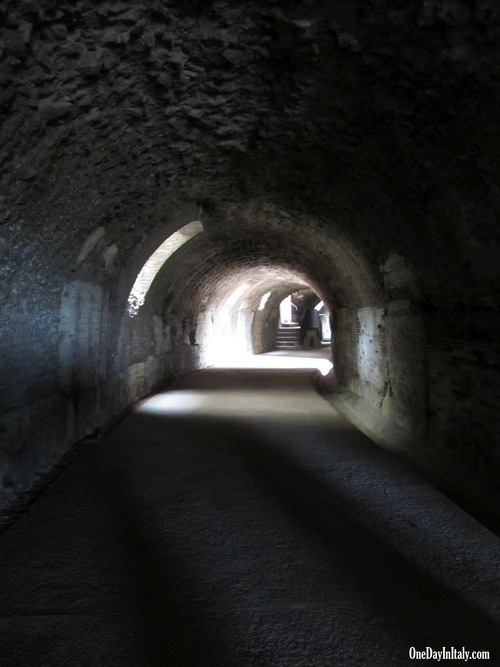
At one time, all of the corridors of the Colosseum were closed in as this one is so you couldn’t see the “show” unless you were in your seats. All I could picture was an ancient Roman missing the killing strike because his date wanted a Diet Coke.
But oh, I forgot – the women sat up top.
The skylights on the side of the corridor were called “mouths of the wolf” because of their shape (didn’t look much like the mouth of a wolf to me, though). These were the only source of light in the corridors.
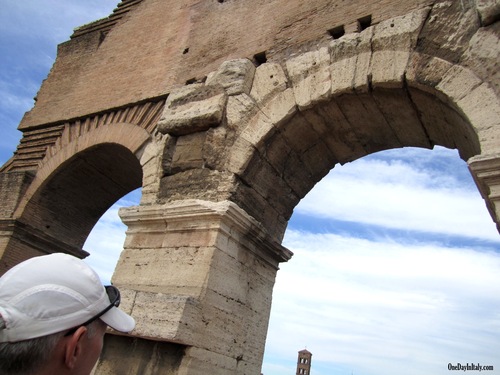
Back outside but still up high, Michele pointed out the two different types of materials used in these arches. ”Anyone know why?” he asked us.
Nope, just tell us.
“One of the rules of restoration: rebuild the structure just as it was but using a different material so no one will ever want to confuse it with the original.” Ahhhhh, interesting. See how the restoration on the left is made of brick, in contrast to the “original” on the right in rough stone?
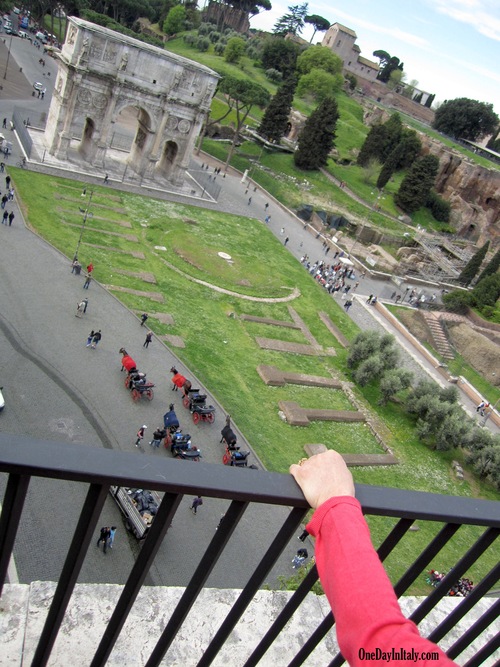
In ancient times, there was a fountain where the white “dot” in the middle of the grass is that did not “fount” water, but instead seemed to “sweat”. There were ruins of the fountain there till WWII, when Mussolini cleared them away to make room for a road.
On the opposite side of the “dot” is the Arch of Constantine. The Roman Senate built this in honor of Constantine’s victory over then-emperor Maxentius in 312AD (this was the battle, by the way, during which Constantine and his troops allegedly converted to Christianity). What’s interesting about this is where they got the stone: they took marble from a handful of other monuments, destroying the old to build the new. Why? Partly for the analogical significance (that Constantine had conquered the old regime) and partly for the limited availability of raw materials.
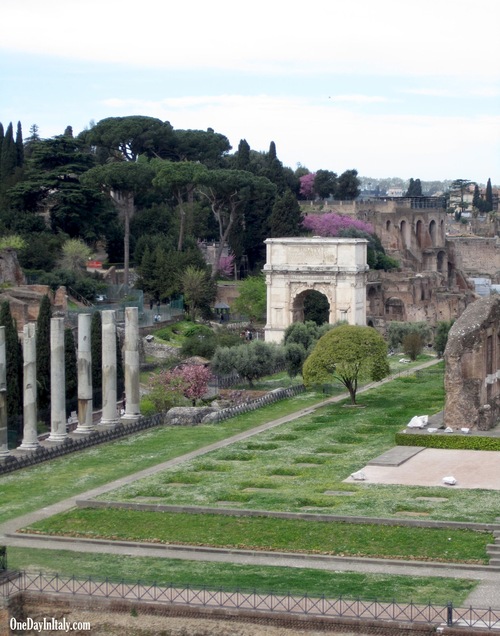
When viewing the Arch of Constantine from the Colosseum, turn your head to the right and you’ll see the Arch of Titus sitting near the Forum & Palatine.
I said in my last post on the Colosseum that the original name for the arena was actually the “Flavian Amphitheater”. Next to the temple on the right of this picture used to be a huge marble and bronze statue of Nero which he called the “Colossus”. Later, the statue was moved to the front of the Colosseum and the face was changed from Nero’s to that of the reigning emperor’s (continuously) and then, finally, to that of the Sun God. So then the statue was the “Colossus of the Sun”. It was only in the middle ages that the common name for the Flavian Amphitheater changed to simply the “Colosseo” (or “Colosseum”, in English).
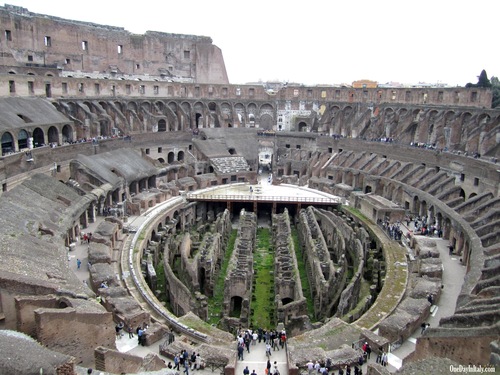
The perfect view, in my opinion. The “Underground Colosseum Tour” was purely wonderful and I’d recommend it to anyone! Make sure you book in advance with the Colosseum’s ticket office (who will speak English to you as soon as you greet them in English over the phone). After snapping this shot of the Colosseum from the highest level – in fact, this was probably the view Roman women would’ve had! Not so bad… – we were free to explore the public areas of the Colosseum on our own before leaving.
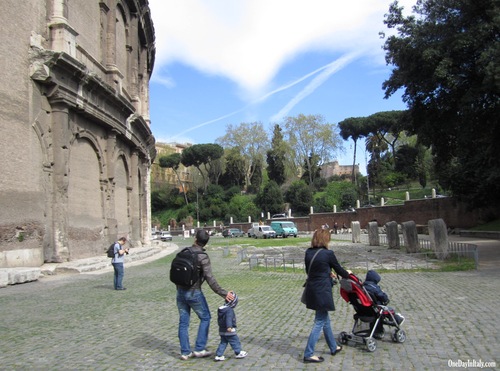
One more fun note: see the short stone pillars on the right? They look just like the ones you see outside of Target, except not painted red. In fact, they had a similar purpose. Chains were strung between them to mark off an area where pedestrians could safely wait and not be run over by unforgiving hooves and carriages.
To book the Underground Tour, you must buy both a regular entrance ticket (around 15 euro) and the tour ticket (an additional 21,50 euro). You can buy both online HERE. If you have a Roma Pass and want to use it for general Colosseum entrance, you MUST call the Colosseum Call Center: +39(0)6 399 67700. I did it; it’s easy.
Comments
comments






%20[%3Ca%20href='function.getimagesize'%3Efunction.getimagesize%3C/a%3E]:%20failed%20to%20open%20stream:%20No%20such%20file%20or%20directory%20in%20%3Cb%3E/home/onedayin/public_html/wp-content/plugins/nextgen-gallery/products/photocrati_nextgen/modules/nextgen_data/class.gallerystorage_driver_base.php%3C/b%3E%20on%20line%20%3Cb%3E1220%3C/b%3E%3Cbr%20/%3E)




Leave a Reply